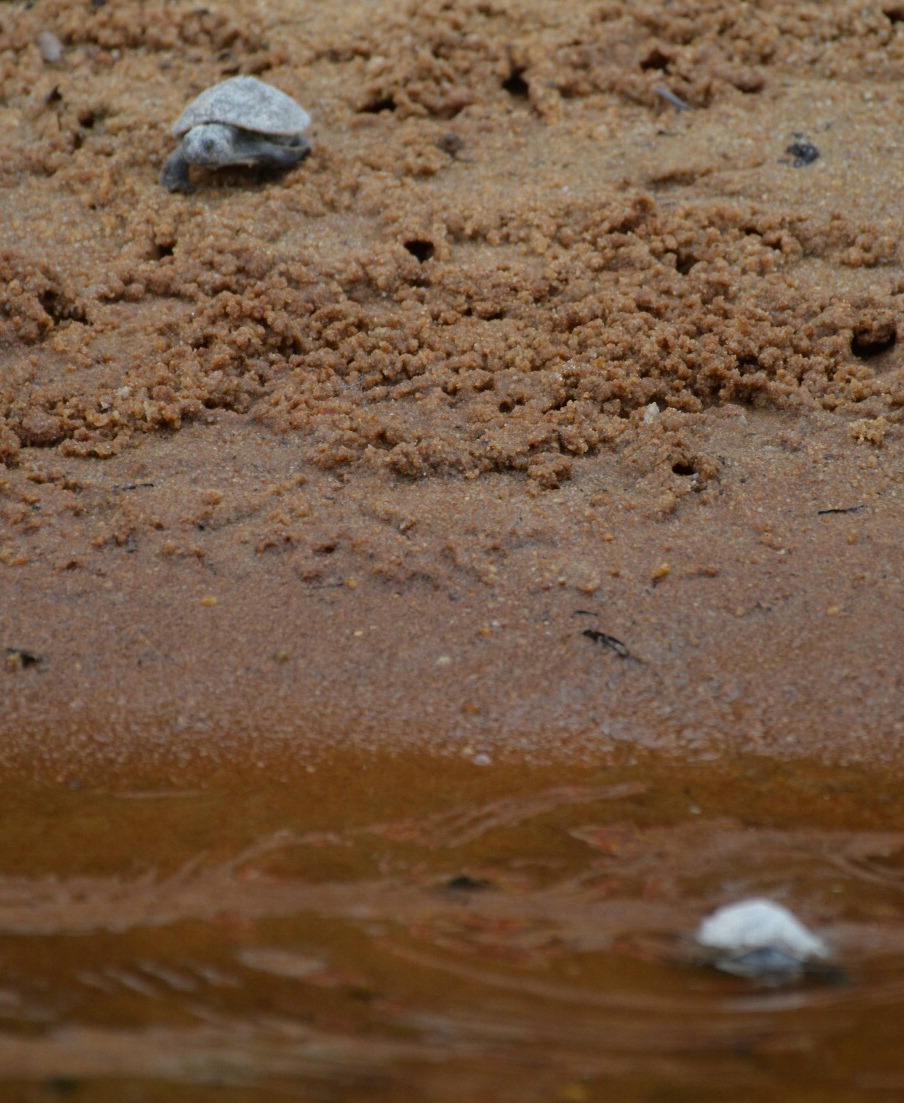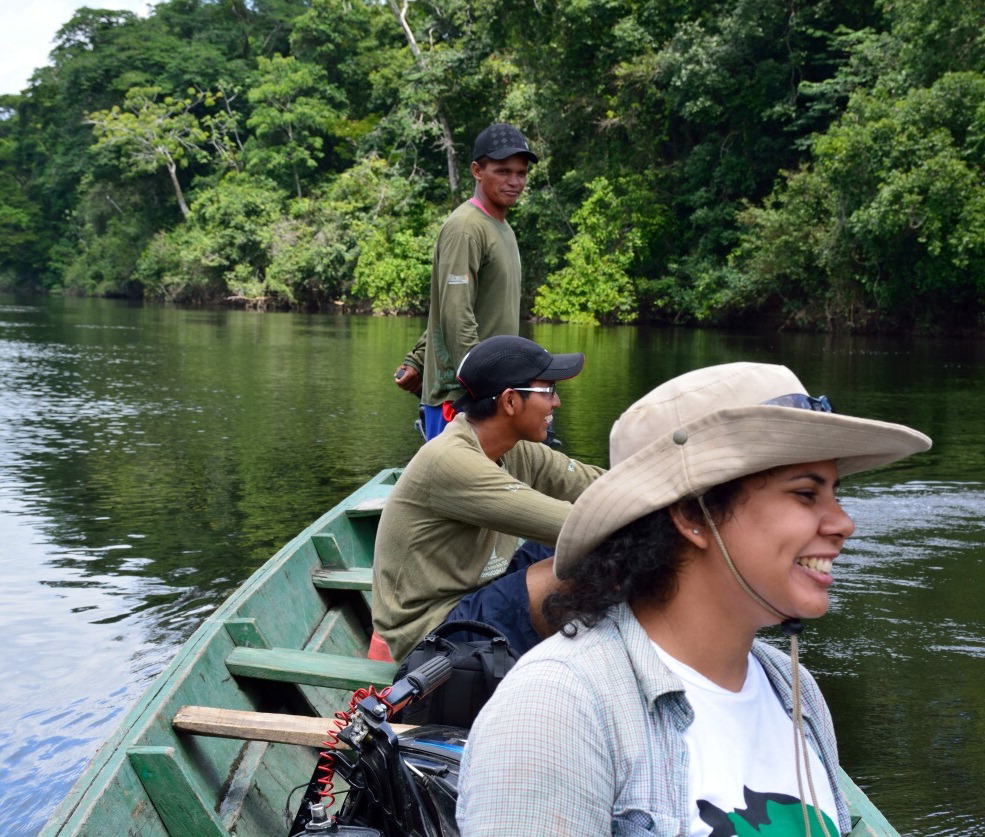|
Cycle 4 (2015 Deadline)
Where is my Turtle? Quantifying biodiversity impacts of hydroelectric expansion and river use changes in the Brazilian Amazon
PI: Darren Norris (dnorris75@gmail.com), University of Amapá
U.S. Partner: James Gibbs, State University of New York College of Environmental Science and Forestry (SUNY-ESF)
Project Dates: October 2015 - June 2020
Project Website: http://myturtlebrazil.wixsite.com/whereismyturtle Project Blog: https://myturtlebrazil.blogspot.com/
Project Overview
 | | Turtle hatchlings take their first swim! |
Semi-aquatic species are impacted by hydroelectric developments and river use changes, and to engage multiple stakeholders (from children to local landowners to electricity companies) Dr. Norris and his colleagues chose to focus on conservation of the river turtle Podocnemis unifilis within a unique socioeconomic development scenario (Amapa State). P. unifilis represent provisioning (food, source of income) and cultural services for Amazon populations (Vogt 2008), and unlike charismatic mammal species like the Giant Otter (Michalski et al. 2012), river turtles do not generate negative perceptions in local human populations (Norris & Michalski 2013). Additionally, river turtles depend on both terrestrial (nesting) and aquatic (feeding/reproduction) environments, which provides multiple opportunities for achieving engagement, research, and biodiversity conservation objectives. In sum, river turtles are thus ideal biodiversity conservation “flagship” species that deliver important ecosystem services and elicit strong affinity in people for the conservation of wild species and their habitats. However, no previous study has robustly quantified a P. unifilis population. A variety of approaches have been used but none incorporate detectability. As such, previous studies only provided estimates of minimum or maximum numbers, which are not suitable for comparison (Norris et al. 2011) and are not associated with population parameters required to inform conservation actions. By integrating data from multiple techniques this project team aimed to provide a robust assessment of P. unifilis movements and demographics. The project also integrated participation of local schools, regional postgraduate courses, lecturers, researchers, students, and people from riverine communities to transfer knowledge and help to create and foster new practices.
Final Summary of Project Activities
 | | Team members survey the river (photo courtesy of Dr. Norris). |
The research team, working alongside local community members, participated in 34 field visits accumulating a total of 8606 km of river-based boat surveys that resulted in 868 detections of individual turtles along the rivers. Over the PEER project period, researchers also monitored 384 nesting areas over the course of five months each year to collect data on the number of turtle nests, and hatchling success. From those 384 nesting areas, they selected a subset of 29 for more intensive monitoring and development of community-based management actions. These actions focused on protecting nests from losses due to predation (e.g., lizards and birds) and flooding.
During the 2019-2020 turtle nesting season, team members successfully installed a river level monitoring system and were able to avoid the most serious nest flooding impacts. Together with the local communities, they took preventive actions so that no eggs were submerged in 2019, in contrast to the devastating losses suffered during the previous year’s nesting season. The new technology provided reliable real-time data that helped avoid the flooding and loss of hundreds of eggs and saved more than 200 hatchlings.
Results from the PEER project were shared through several publications, dozens of technical presentations, and conferences. The team developed extracurricular activities for children from three local schools, using conservation of the tracajas as learning inspiration, and helped clean beaches around the reservoir formed by the dam, which are used by both people and turtles.
The PI contributed to a "Green List" Assessment of the turtle species Podocnemis unifilis for inclusion and evaluation by the International Union for Conservation of Nature (IUCN). This was carried out in collaboration with Dr. Molly Grace at the University of Oxford (UK). A Green List assessment is an optimistic vision of species conservation that presents a road map on how to preserve a species and facilitate its recovery.
The research has also contributed to several National Biodiversity Targets for Brazil and informed mitigation strategies to reduce biodiversity losses following the construction of the dam. This includes a proposal for the restoration of turtle nesting areas that is included in the ongoing licensing renewal process for the dam operator.
Publications
Andrea Bárcenas-García, Fernanda Michalski, James P. Gibbs, and Darren Norris. 2022. Amazonian run-of-river dam reservoir impacts underestimated: Evidence from a before–after control–impact study of freshwater turtle nesting areas. Aquatic Conservation 32(3): 508-522. https://doi.org/10.1002/aqc.3775
Fernanda Michalski, Darren Norris, Itxaso Quintana, Andressa Valerio, and James P. Gibbs. 2020. Substrate influences human removal of freshwater turtle nests in the eastern Brazilian Amazon. Scientific Reports 10:8082. https://doi.org/10.1038/s41598-020-65074-1
Angga Rachmansah, Darren Norris, and James P. Gibbs. 2020. Population dynamics and biological feasibility of sustainable harvesting as a conservation strategy for tropical and temperate freshwater turtles. PLoS ONE 15(2): e0229689. https://doi.org/10.1371/journal.pone.0229689
I. Quintana, D. Norris, A. Valerio, F.G. Becker, J.P. Gibbs, and F. Michalski. 2019. Nest removal by humans creates an evolutionary trap for Amazonian freshwater turtles. Journal of Zoology 309: 94-105. https://doi.org/10.1111/jzo.12689
Darren Norris, Carlos A. Peres, Fernanda Michalski, and James P. Gibbs. 2019. Prospects for freshwater turtle population recovery are catalyzed by pan-Amazonian community-based management. Biological Conservation 233: 51- 60. https://doi.org/10.1016/j.biocon.2019.02.022
Darren Norris, Fernanda Michalski, and James P. Gibbs. 2018. Community involvement works where enforcement fails: conservation success through community-based management of Amazon river turtle nests. PeerJ 6: e4856. https://doi.org/10.7717/peerj.4856
Darren Norris, Fernanda Michalski, and James P. Gibbs. 2018. Beyond harm's reach? Submersion of river turtle nesting areas and implications for restoration actions after Amazon hydropower development. PeerJ 6: e4228. https://doi.org/10.7717/peerj.4228
Back to PEER Cycle 4 Grant Recipients
|





